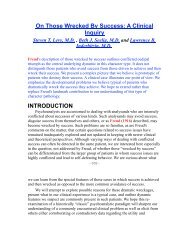A Sadomasochistic Transference - Beth J. Seelig, MD
A Sadomasochistic Transference - Beth J. Seelig, MD
A Sadomasochistic Transference - Beth J. Seelig, MD
You also want an ePaper? Increase the reach of your titles
YUMPU automatically turns print PDFs into web optimized ePapers that Google loves.
it, asking "Do you have any Kleenex?" The analysis continued to have stormy<br />
times, but they became briefer and could be subjected to analytic scrutiny.<br />
Some New Memories and Psychodynamic<br />
Formulations<br />
When Miss T said, "I don't think it'll be a good analysis, but there's no choice,<br />
so we'll stay in this battle for years and years," she was making a transference<br />
statement that appears to have been related to a failure in the rapprochement<br />
subphase of the separation-individuation process (as described by Mahler et al.,<br />
1975). Unable to fully separate, she was alternately rageful and repentant. This<br />
"battle" was the only mode of intimate relating she knew. The intense hostiledependent<br />
bond with the analyst and the repudiation of the possibility of<br />
triangulation had been presaged in the initial dream, in which she rejected the offer<br />
- 978 -<br />
"to make it up" made by the male analyst. The reedition in the transference of the<br />
hostile-dependent bond had to be analyzed before she could go on to deal with<br />
oedipal triadic issues. (It is worth noting that Miss T.'s negative oedipal<br />
transference contributed to the paranoid quality of her transference regression.)<br />
As interpretation and working through of this transference paradigm<br />
progressed, Miss T. began to recall previously repressed or ignored historical<br />
material and to question relatives about events in her early life. Her mother had<br />
reacted to evidence that Miss T. was left-handed, as was her next older sister, with<br />
the belief that her less than one-year-old baby daughter was showing precocious<br />
sibling rivalry. Mother felt that the baby's lefthandness was somehow a<br />
manifestation of her effort to "compete" with her sister! When Miss T. began to<br />
read at age four, this achievement was labeled as bad because it was "too early,"<br />
another proof that the child was trying to outdo her sisters. This material was not<br />
mentioned until well into the analysis. She had not mentioned it as she had<br />
actually believed she had "made herself" left-handed in an effort to compete, and<br />
that her mother was probably right when she accused her of learning to read at<br />
"too early" an age. Not until the analyst expressed surprise when she mentioned<br />
these ideas did Miss T. first start to question them consciously. They had been<br />
presented by the mother as fact, and Miss T. had been unable to utilize any other<br />
viewpoint to help her discredit her mother's views.<br />
Retrospectively, it appears that Miss T.'s early development had been<br />
disrupted by a pathological bond with her mother, in which she felt the latter both<br />
torpedoed her initiative (sense of agency) and lacked interest in her inner life.<br />
Yet this was not a simple case in which a daughter felt rejected or criticized<br />
by her mother; she also felt her mother simultaneously bound her to her and tried




